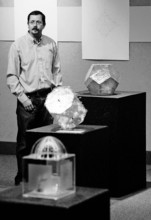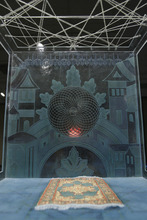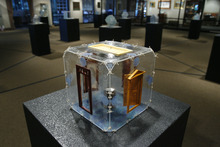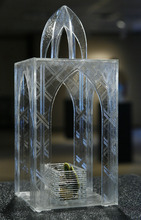This is an archived article that was published on sltrib.com in 2011, and information in the article may be outdated. It is provided only for personal research purposes and may not be reprinted.
West Valley City • Andrew Kosorok was disturbed when some Americans began to view Islam as a religion of violence after the attacks of Sept. 11, 2001.
"The overwhelming majority of Muslims view the terrorists as the overwhelming majority of Christians view Charles Manson or David Koresh," said Kosorok, an artist and Brigham Young University adjunct professor. "We don't recognize what they practiced as being Christian."
But Kosorok, a soft-spoken man with a self-deprecating sense of humor, didn't want to fight about it. He didn't want to lecture. Instead, he sought to create understanding the best way he knew how — through art.
Now, 10 years and thousands of hours of painstaking work later, Kosorok's art is on display at the Utah Cultural Celebration Center in West Valley City. The 16 glass sculptures represent the beginning of Kosorok's quest to create 100 sculptures representing the 99 names of Allah or God within Islam and one sculpture representing his reaction to the process.
"He has studied so much and is so knowledgeable and passionate about explaining Islam in a way that you're not hearing or seeing in popular culture or on news channels," said Michael Christensen, folklorist/cultural specialist at the celebration center.
But Kosorok, a member of The Church of Jesus Christ of Latter-day Saints, is the first to concede he is no expert on Islam. So when he embarked on the project, he contacted members of Utah's Muslim community, religious leaders and scholars around the world to learn more about the faith.
That's how he came upon the 99 names of Allah, names that represent characteristics of God. According to one hadith, a saying of Muhammad, a man once approached the prophet and asked him how to enter into paradise. Muhammad responded that understanding and living by 99 names of Allah were key to entering paradise.
Some of the names are meant to emulated, such as The Compassionate, The Merciful and The Forgiving, Kosorok said. Others are to be respected, such as The Guardian, The Compeller and The Giver of All. Most of the names are found in the Quran.
They are names that may seem at odds with how some Americans have come to view Islam.
"The reason for doing the artwork," Kosorok said, "is because as I was finding out and learning things. I wanted to share what I was learning with other people."
Now, on the 10th anniversary of the Sept. 11 attacks, he is getting that chance.
The 16 geometric glass figures will sit upon pedestals, shining under the gallery lights at the celebration center until Oct. 11. Each piece holds layers of meaning, expressed through shape, design, color, symbol and construction.
For example, a sculpture resembling a multi-pointed star, a shape technically called a stellated dodecahedron, sits in a corner of the gallery. The sculpture, named Giver of All, illustrates the belief that God is the source of all things and that human skills are best when used in the service of God. Kosorok said the piece is based on a story from Islamic Sufi tradition, in which Jesus Christ is recognized as first among saints, but not the messiah.
According to the story, an artist approached Jesus while he sat at a river's edge. The artist showed Jesus a work he had just finished and asked his opinion. Jesus, in turn, said nothing, instead scooping up a handful of clay from the riverbank and sculpting it into a small bird. Jesus breathed on the bird and it became real, flying away. Jesus looked at the artist and, according to Kosorok, said, "When you have the skill to give what only God can give to your work, you will have the right to be proud of it."
The sculpture illustrates the story. Its shape is meant to resemble a Middle Eastern lantern, representing light or knowledge. The work is constructed out of triangular glass pieces, some of which contain etchings reminiscent of Mediterranean petroglyphs of birds. Some of the glass is opaque and some transparent, symbolizing the process of spiritual learning, a search for clarity.
As in many of the figures, hemp ties strung through small holes ringed with gold-colored eyelets help hold together the glass pieces. It's a method modeled after medieval bookbinding techniques, which Kosorok used to emphasize the importance of books, and especially the Quran, in Islam.
The figure, like many of the others, also stands 11.25 inches tall, a measurement that equals five-eighths of a cubit, an ancient unit of measurement. Five and eight are religiously significant numbers. In Islam, there are five pillars of faith and eight refers to the number of angels that will carry God's throne at the Last Judgment, Kosorok said. They are numbers he has incorporated into a number of the pieces.
In any Muslim art, symbols, numbers, shapes, colors and words often communicate the message, because portrayals of Allah in a human form are considered inappropriate.
Ghulam Hasnain, a friend of Kosorok's and president of the Salt Lake American Muslim social-service agency, said Kosorok's respect for that and other Muslim conventions is key to his artwork. He said otherwise works such as Kosorok's could backfire.
"There are all kinds of people interested in Muslims and Islam but for the wrong reasons," said Hasnain, who is Muslim and attended the recent opening reception of the exhibit. "He not only intends well, but he's going about it in the proper way."
West Valley City resident Ibtissam Elfajri, who also attended the opening, called the pieces "beautiful" and "touching."
"It means a lot to me," said Elfajri, who is also Muslim. "Islam is about peace, accepting other people's differences and learning from each other."
Kosorok hopes others see that in his work.
"When people see the exhibit, I want them to be excited about art, for one thing," Kosorok said, "but I also want them to learn something about someone they fear and maybe take away some of that fear."
Kosorok acknowledges receiving some criticism for being a non-Muslim trying to make art based on Islamic beliefs. But he hopes those who view the exhibit understand that the pieces are not meant to be straightforward representations of Muslim values.
Instead, they are more about his personal journey of learning told from his own perspective as a Christian.
"I'm not looking to say, 'Look what I found out about your faith. I know it better than you,' " Kosorok said. "I'm trying to learn and show respect for their belief system."
Unlike the artist who stood with Jesus by the river, he views his art humbly.
To see the exhibit
P The exhibit, "99 Most Beautiful Names: A Sculptural Presentation of the Names of God From the Quran," will be at the Utah Cultural Celebration Center, 1355 W. 3100 South, West Valley City, until Oct. 11. The display can be toured Monday through Thursday from 9 a.m. to 6 p.m. or by arrangement. —
The art of faith — a yearlong series
P The Salt Lake Tribune is featuring a monthly series this year about religious art. Today: Muslim sculptures.
To view previous stories in the series, go to http://www.sltrib.com













